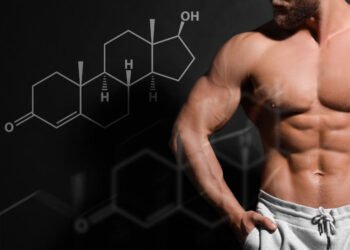Deficiency in AGH can manifest as an atypical phenotype characterized by dwarfism or reduced stature, while acquired GH deficiency can lead to sudden alterations in physiological processes during later stages of life.
Due to the significant prevalence of growth hormone (GH) deficiency, numerous synthetic peptides, such as growth hormone-releasing peptides (GHRPs), have been introduced to facilitate the stimulation of endogenous growth hormone (GH) secretion.
One specific growth hormone-releasing peptide (GHRP) that we are discussing is growth hormone-releasing peptide 2 (GHRP-2). One distinguishing characteristic of GHRP-2, compared to other GHRPs, is its progression to phase 2 research trials and its ongoing investigation and studies into its enduring impacts.
Let us thoroughly examine the various facets of GHRP-2 and explore its implications for researchers interested in exploring this substance in laboratory conditions.
What is GHRP-2 Peptide?
GHRP-2, known as Pralmorelin, is a laboratory-created growth hormone secretagogue (GHS). From a structural standpoint, this compound can be classified as a hexapeptide. It consists of a polypeptide chain that lacks glycosylation and comprises six amino acids arranged in the following sequence: H-D-Ala-D-2-Nal-Ala-Trp-D-Phe-Lys-NH2 [i].
Studies suggest that among the initial and highly effective constituents of the growth hormone-releasing peptides (GHRPs) group, this particular member is additionally employed as a peptide for diagnostic purposes in identifying growth hormone (GH) deficiency.
GHRP-2 Peptide: Mechanism of Action
In order to comprehend the mechanism of action of GHRP-2, it is imperative to gain a fundamental understanding of the functioning of growth hormone secretagogues (GHSs) as a whole.
Research suggests growth hormone secretagogues (GHSs), including GHRP-2, may exhibit a high affinity for multiple growth hormone secretagogue receptors (GHS-Rs), including the pituitary gland, pancreas, and cardiac tissue.
The subsequent interaction between growth hormone secretagogues (GHSs) such as GHRP-2 and growth hormone secretagogue receptors (GHS-Rs) initiates the release of growth hormone from the somatotrophs found in the anterior pituitary gland, leading to the activation of a cascade of physiological responses [ii].
Researchers speculate that, like other pituitary hormones, the release of somatostatin or growth hormone-inhibiting hormone (GHIH) may also be suppressed by GHRP-2 due to the operation of a negative feedback mechanism. This mechanism may guarantee the absence of adverse feedback, sustains growth hormone release, and maintains elevated levels.
Scientists hypothesize GHRP-2 may exert its potential action via modulating the ghrelin system. From a broader perspective, ghrelin is commonly known as the “hunger hormone,” predominantly secreted by gastric cells. Ghrelin is a naturally occurring hormone that acts as a growth hormone secretagogue (GHS) by binding to the growth hormone secretagogue receptor (GHS) [iii].
Studies suggest the potential activation of ghrelin by GHRP-2 may lead to the subsequent release of growth hormone (GH). Certain investigations suggest that GHRP-2 may have a role in the upregulation of hormone release from the pituitary gland, including hormones like prolactin and ACTH.
GHRP-2 Peptide Properties
Research suggests GHRP-2 may exhibit many multifunctional properties, presenting an extensive array of potential and an extensive catalog of its effects.
Scientists hypothesize the presentation of GHRP-2 may trigger the release of growth hormone, which may promote muscle growth by stimulating protein synthesis and inhibiting protein breakdown within the muscle cells. According to pharmacodynamics, it is suggested that GHRP-2 may exhibit inhibitory action on muscle atrophy. This phenomenon ultimately augments lean muscle mass. [iv]
Additionally, researchers speculate GHRP-2 may initiate the physiological mechanism of lipolysis by diminishing adipose tissue accumulation. This intervention may enhance the overall lean body composition and facilitate weight reduction [v].
Calcium is crucial in bone formation; sufficient mineralization is imperative for enhancing skeletal structure and articulations. Studies suggest the presentation of GHRP-2 may stimulate growth hormone secretion, which plays a crucial role in maintaining calcium homeostasis.
Recent scientific studies have also suggested that GHRP-2 may influence the cardiovascular system by reducing the likelihood of apoptosis in cardiac cells [vi]. This may exhibit comprehensive cardio-protective properties, particularly following myocardial infarction, in which heart cells are more vulnerable to ischemic and hypoxic injury.
Certain data suggest that presenting GHRP-2 may facilitate the recuperation process following injuries by promoting the proliferation of stem cells in the affected area.
GHRP-2 has also been suggested to induce anti-aging properties and may postpone the initiation of age-associated deterioration in both physical and cognitive well-being.
Empirical research data suggests the potential involvement of GHRP-2 in augmenting thymic functionality, thereby fortifying the immune system. GHRP-2, a growth hormone-releasing peptide, may facilitate T cell development, thereby enhancing the immune response against pathogenic infections [vii].
The compounds mentioned in this article have not been approved for human consumption; therefore, licensed professionals can only use them in laboratories. Click here to learn more about peptides.
References
[i] Chen C, Clarke IJ. Effects of growth hormone-releasing peptide-2 (GHRP-2) on membrane Ca2+ permeability in cultured ovine somatotrophs. J Neuroendocrinol. 1995 Mar;7(3):179-86. doi: 10.1111/j.1365-2826.1995.tb00745.x. PMID: 7606243.
[ii] Laferrère B, Abraham C, Russell CD, Bowers CY. Growth hormone releasing peptide-2 (GHRP-2), like ghrelin, increases food intake in healthy men. J Clin Endocrinol Metab. 2005 Feb;90(2):611-4. doi: 10.1210/jc.2004-1719. PMID: 15699539; PMCID: PMC2824650.
[iii] Pradhan G, Samson SL, Sun Y. Ghrelin: much more than a hunger hormone. Curr Opin Clin Nutr Metab Care. 2013 Nov;16(6):619-24. doi: 10.1097/MCO.0b013e328365b9be. PMID: 24100676; PMCID: PMC4049314.
[iv] Hu R, Wang Z, Peng Q, Zou H, Wang H, Yu X, Jing X, Wang Y, Cao B, Bao S, Zhang W, Zhao S, Ji H, Kong X, Niu Q. Effects of GHRP-2 and Cysteamine Administration on Growth Performance, Somatotropic Axis Hormone and Muscle Protein Deposition in Yaks (Bos grunniens) with Growth Retardation. PLoS One. 2016 Feb 19;11(2):e0149461. doi: 10.1371/journal.pone.0149461. PMID: 26894743; PMCID: PMC4760683.
[v] Laferrère B, Abraham C, Russell CD, Bowers CY. Growth hormone releasing peptide-2 (GHRP-2), like ghrelin, increases food intake in healthy men. J Clin Endocrinol Metab. 2005 Feb;90(2):611-4. doi: 10.1210/jc.2004-1719. PMID: 15699539; PMCID: PMC2824650.
[vi] Muccioli G, Broglio F, Valetto MR, Ghè C, Catapano F, Graziani A, Papotti M, Bisi G, Deghenghi R, Ghigo E. Growth hormone-releasing peptides and the cardiovascular system. Ann Endocrinol (Paris). 2000 Feb;61(1):27-31. PMID: 10790589.
[vii] Taub DD, Murphy WJ, Longo DL. Rejuvenation of the aging thymus: growth hormone-mediated and ghrelin-mediated signaling pathways. Curr Opin Pharmacol. 2010 Aug;10(4):408-24. doi: 10.1016/j.coph.2010.04.015. Epub 2010 Jun 4. PMID: 20595009; PMCID: PMC2914845.












